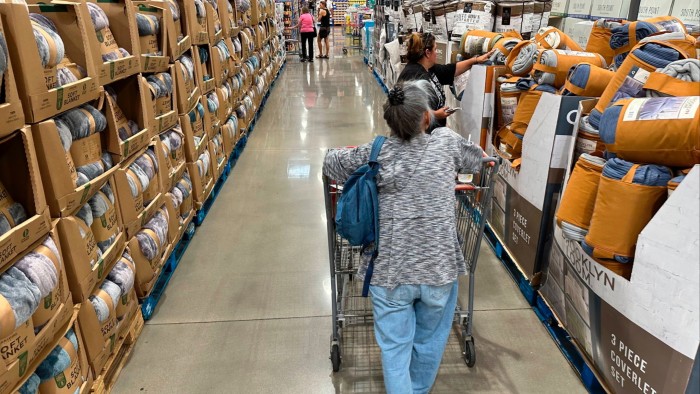Inflation-scarred American consumers are putting up with long lines and paying cash for the privilege of shopping at members-only stores, which are capturing an ever-large share of the US retail sector.
Costco, Sam’s Club and BJ’s Wholesale Club have lured more customers with the promise of low prices on carefully curated items sold in bulk.
Visiting the stores often means wandering aisles formed by towers of merchandise stacked atop shipping pallets, with scarce navigational help from sales clerks. Car parks can be jammed, with vehicles backed up 10 deep for Costco petrol.
But to varying degrees, the chains are investing to streamline the experience, heaping pressure on traditional retailers that rely on higher mark-ups.
The boom in warehouse clubs is among the effects of inflation that left US consumer prices 26 per cent higher than in 2019, before the Covid-19 pandemic. Consumer surveys show continued anxiety over inflation as the US imposes tariffs on trading partners.
“Through good times we do well, and through times that are tough we do even better,” said Chris Nicholas, chief executive of Sam’s Club US, which has $92.6bn in sales.
Sam’s Club, a unit of retail group Walmart, reported same-store sales rose by 6.7 per cent in the first quarter, excluding fuel, outpacing the growth at its corporate parent’s namesake US stores.
Costco, with $254.5bn in annual revenue, on Thursday disclosed a 7.9 per cent comparable US sales increase, also excluding fuel. BJ’s, with revenue of $20.5bn, last week reported a 3.9 per cent rise in comparable sales, excluding the volatile impact of petrol prices.
By comparison, same-store sales at top US supermarket chains Kroger and Albertsons are expected to have risen by 2 per cent when they next report results, according to Visible Alpha. Sales fell at Target and Macy’s, the big-box and department store chains.
“These companies right now, they’re expanding at a good pace and over time just making their proposition with consumers very sticky,” said Robert Altun, analyst at RetailStat.
The three big chains are adding millions of square feet in US retail space: Costco is aiming to bring 15 online this year. BJ’s plans to open 25 to 30 in the next two years. Sam’s Club, which shuttered 63 locations in 2018, now intends to open 15 new clubs annually “for the foreseeable future”.
At the grand opening of a new BJ’s on New York’s Staten Island last month, shoppers passed through an archway of balloons to reach a member service counter urging them to “Join the Club”.
Denise Carrasquillo and her husband Ray said they had already done so as they pushed a cart with groceries including milk, cooking oil and pastrami.
“When you have places like BJ’s and Costco and Sam’s Club, it helps,” said Denise, a mother of three. “Because overall, even though you are paying out of hand a little bit more, when you break everything down your savings is much higher.”

The membership club store model was pioneered by a retailer named Sol Price, who launched his Price Club chain in southern California in the 1970s. In 1993 Price Club merged with Costco. Sam Walton, Walmart’s founder, admitted to stealing Price’s concept when he created Sam’s Club in 1983. Massachusetts-based BJ’s emerged a year later.
All three charge membership fees — basic tiers cost $50 a year at Sam’s Club, $60 at BJ’s and $65 at Costco — in return for access to stores. The latter two have raised fees in the past year but member counts continue to rise, with nine in 10 choosing to renew.
At Sam’s Club, 80-90 per cent of profits came from membership income, Todd Sears, chief financial officer, told investors last month.
In return, customers get a stripped-down assortment of several thousand items that they trust will be the cheapest around. These can range from 36 rolls of toilet paper to cases of Bordeaux wines, for a clientele that is slightly more affluent than average.
“They basically take the process of bargain hunting, pay Costco or Sam’s a fee, and outsource it to them,” said Bryan Gildenberg, managing director of Retail Cities, a consultancy.
The clubs put pressure on vendors such as Procter & Gamble and Nestlé to keep prices low by selling competing house brands. Costco’s Kirkland Signature and Sam’s Club’s Member’s Mark private label brands are worth tens of billions of dollars each.
While customers may stomach clubs’ fees, they also confront a less convenient shopping experience. Stores are far apart: the sum of Costco, Sam’s Club and BJ’s US locations is still less than a third of Walmart’s 4,600 US stores.
“It’s a little bit of a grudge shop — you don’t want to spend your Saturday afternoon roaming around a 100,000 sq ft box,” Bob Eddy, BJ’s chief executive, said on a webcast in April.
At Costco, customers are corralled to show receipts to employees as they exit the store, slowing down shopping trips. BJ’s and Costco did not respond to requests for comment.
Foot traffic data compiled by Advan Research shows that shoppers spent about 13 per cent more time inside Costco, Sam’s Club and BJ’s US stores than they did in conventional supermarkets during the first quarter.
All three big warehouse clubs are also encroaching on the turf of Amazon, filling online orders at stores or through home delivery, sometimes through a third party such as Instacart.
And the stores are trying to attack what Nicholas calls “friction”. Sam’s Club allows customers to scan and pay with their phones, while cameras outfitted with computer vision check contents of shopping carts against their digital receipts. The technology has sped up exit times by 23 per cent, Todd Garner, Sam’s Club’s chief product officer, said on a store tour in Grapevine, Texas.
“They’re not waiting. They’re not queueing. They’re literally just walking out,” Garner said.




